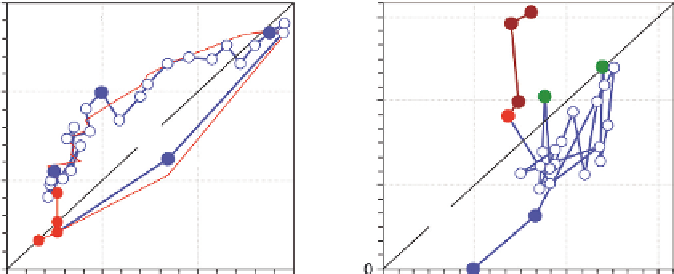Geoscience Reference
In-Depth Information
Figure 7.7
Input and output fluxes of S and inorganic N in catchments of the
Bohemian Forest lakes (Czech Republic). (a) 'S leaching from' versus 'S deposition to' the
catchment of
ˇ
ertovo Lake. The blue points are based on measured data (Kopáˇek
et al
.
2006a), red points and lines are simulated by MAGIC (Majer
et al
.
2003). (b) 'NO
3
-
leaching from' versus 'NH
4
-N + NO
3
-N deposition to' the catchment of Plešné Lake. The
blue points are based on measured data. Other colours represent extremely high
N-exports (exceeding N deposition) due to: severe winters (green, 1986 and 1996);
extremely dry and hot summer 2003 (red, 2004); and forest dieback caused by bark
beetle infestation (brown, 2005-7). (Data from Kopá
ˇ
ek
et al
. 2006b.)
The recovery of previously damaged forests, including many in central Europe
with a legacy of heavy acid deposition and N saturation, can be expected to
cascade down to the streams draining them and to lakes supplied by the streams.
In the Bohemian Forest, Czech Republic, there has been high NO
3
leaching,
exceeding atmospheric input of inorganic N (Fig. 7.7) to lakes,
ˇ
ertovo and
Plešné (Majer
et al
. 2003; Kopáˇek
et al
. 2006a). At
ˇ
ertovo Lake, S input-
output budgets show significant hysteresis compared with the 1: 1 line of export
to import, with the current leaching substantially higher than that at the beginning
of the 20th century at the same level of S deposition. There are apparently no
anomalies related to climatic conditions. Nitrate at Plešné Lake, on the other
hand, shows major changes in response to climatic variations. NO
3
concentrations
were negligible in the 1930s and increased around the 1950s, when N deposition
exceeded 70 mmol m
−2
yr
−1
(10 kg N ha
−1
yr
−1
). NO
3
leaching declined after the
decline in N deposition, but the catchment remains N-saturated and the current
NO
3
leaching is higher than that in the 1960s at similar N deposition rate.
Extremely high N exports, exceeding N deposition, occurred in 1986 and 1996
after severe winters, in 2004 after extremely dry and hot summer 2003, and in
2005-7 after forest dieback due to bark beetle infestation in the catchment
(Kopáˇek
et al
. 2006b).
The increased terrestrial NO
3
export following climatic anomalies (hot and
dry summer 2003) and forest dieback (2005-8) was associated with high leaching
of ionic Al and loss of base cations from the soil (Fig. 7.8). Nitrate has become






















































































Search WWH ::

Custom Search